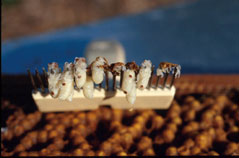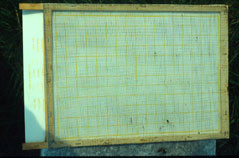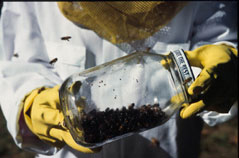
Survey methods provide presence/absence information. One such method is the “cappings scratcher,” which requires one to impale a number of capped drone cells with a cappings scratcher, and then to pull the immature drones from their cells for examination (photo D). This method has been found to be highly effective in detecting mites when present at very low levels. A second survey tool is the “sticky-board,” which takes advantage of the fact that mites often fall off of bees. Typically, a piece of paper is covered with a sticky substance (petroleum jelly or a vegetable spray) and inserted into the hive where it rests, sticky-side up, on the bottom board. The sticky-board must be protected from the bees. One way to do this is to build a wooden frame, cover one side with 1/8” hardware cloth, and attach the sticky-board to the other side (photo E). Sticky-boards are also available commercially. The board is removed after 24 or 48 hours and the mites are counted. Strictly speaking, the sticky board does not provide information about pest density; however, it is often used for that purpose. Lastly, mites can sometimes be seen on adult bees or walking on the comb, but this is more common when infestation rates are very high and should not be relied on as a diagnostic method.

Sampling methods provide an estimate of pest density. This is the type of information needed to determine whether to apply a pesticide. One method is the “ether-roll,” which provides an estimate of pest density in terms of mites per standard volume of bees. Bees are collected from two or three brood-nest combs and placed in a quart glass jar. If only a few colonies are being sampled, shake bees directly into a dishpan. Scoop up ½ cup of bees and quickly pour them into the quart jar. If larger numbers of colonies are being sampled, a modified “Dust Buster” (DC Insect Vac from BioQuip®) can be used to collect a standard volume of bees, which are then transferred to the quart jar. You will need to experiment with the vacuum collector to determine the exact volume that yields about 300 bees. Spray a three-second burst of an automotive starting fluid into the jar, replace the lid, shake vigorously for 10 seconds, and then toss and roll the jar three times along its long axis. Mites, if present, will be seen adhering to the sides of the jar (photo F). This method detects 50 to 60% of the mites actually present in the sample. The resulting ether roll count is usually converted to a standardized 300-bee ether roll count (SER) using the formula:
SER = (ER) / (#B/300),
where ER is the ether roll count for the sample and #B is the number of bees in the sample.
An improvement in accuracy can be obtained by calculating the actual mite-to-bee ratio. This is done by collecting the bees as above and then separating the mites from the bees by agitating them for five minutes in a container with soapy water or alcohol and straining through a 1/8” hardware cloth screen. The screen catches the bees but allows the mites to pass through. Typically, bees are washed several times to remove all of the mites. Mites and bees are counted and the actual mite-to-bee ratio is calculated. You can convert the mite-to-bee ratio to a standardized 300-bee ether roll count using the formula:
SER = ((R * #B) / 1.783) / (#B / 300),
where R is the mite-to-bee ratio in the sample and #B is the number of bees in the sample. The conversion factor (1.783) is from Calderone and Turcotte (1998) [1].

Remember! For an estimate of pest density to be meaningful, each step in the sampling method must be standardized. This means monitoring mite levels at the same time each year, and monitoring all colonies exactly the same way. For the ether roll, this means collecting samples from the same place in each colony (tow or three brood nest combs), collecting the same number or volume of bees in each sample, applying the same amount of starting fluid, and shaking the jar in the same manner. For the sticky-board, the same size board must be used each time, the sample must be collected at the same time each year, and the board must be left in place for the same length of time.
The decision to use or not to use a pesticide is based on an economic threshold. This is the pest density at which economic damage is expected if a treatment is not applied. Economic thresholds for V. destructor vary widely throughout the country. The values used below are based on studies conducted in the Midwest and Northwest, where blooming patterns, length of winter and winter temperatures are similar to those in the Northeast. Significantly different values are used in other parts of the country. Beekeepers should contact their local extension apiculturist for the most current recommendations for their area.
